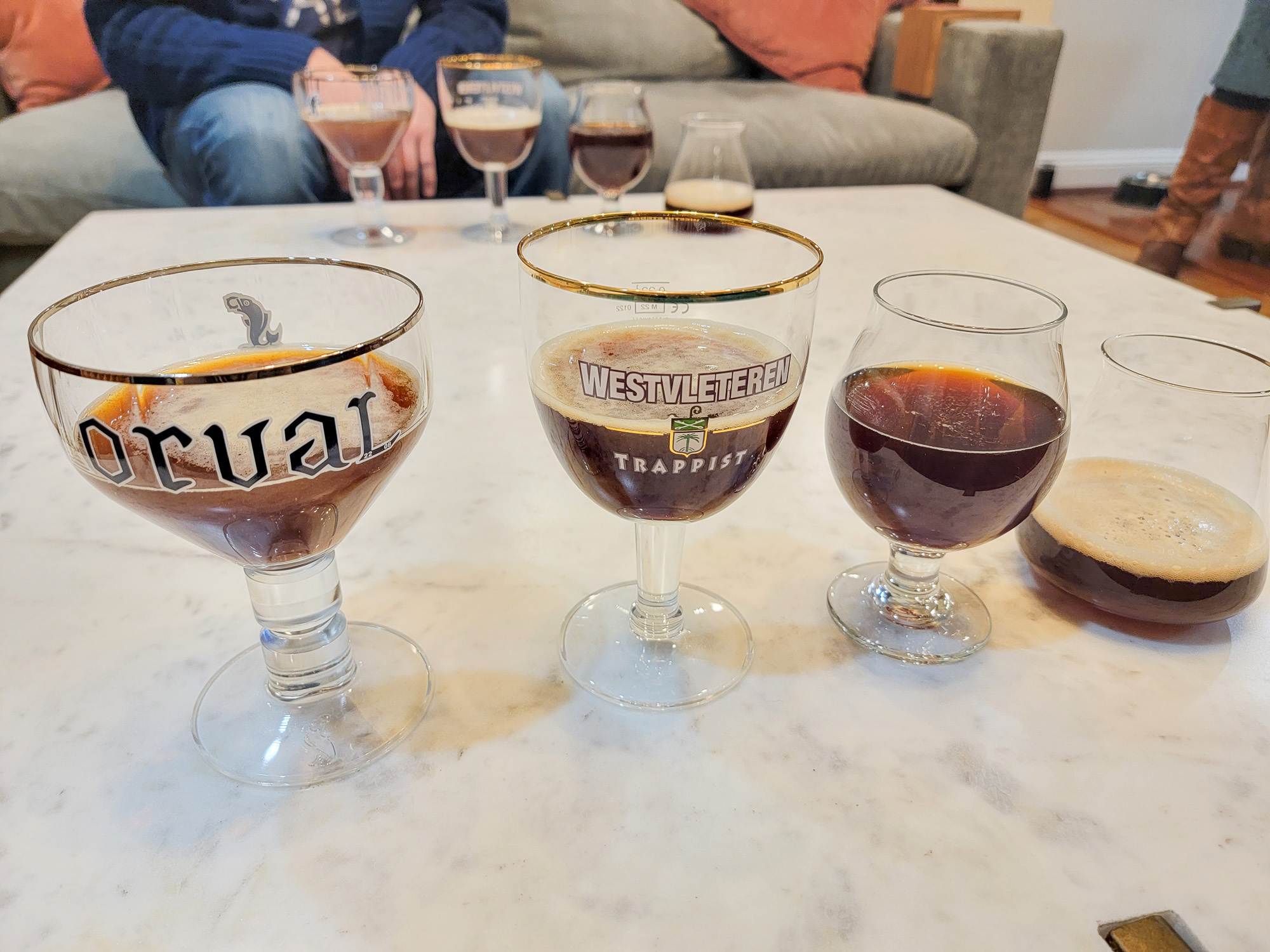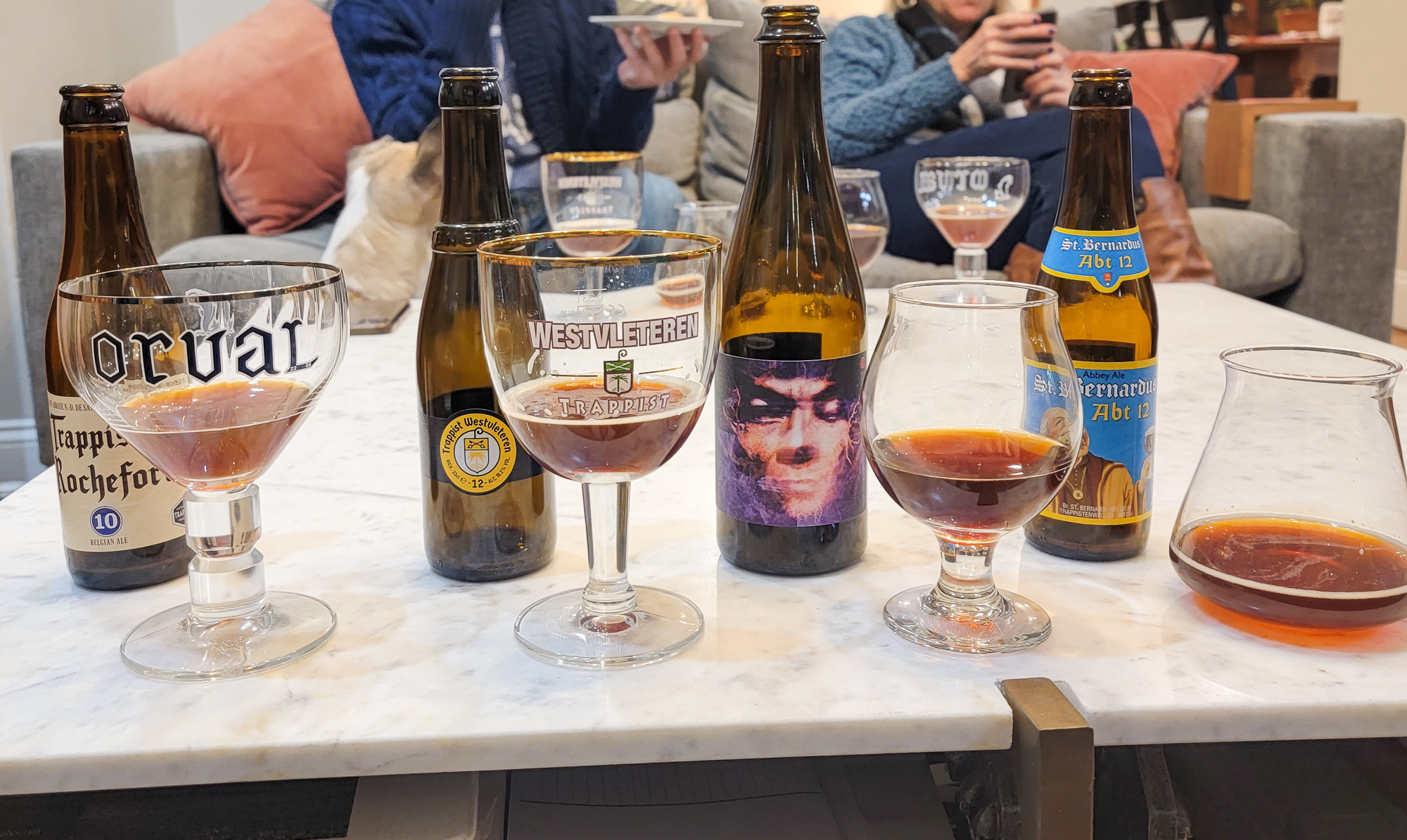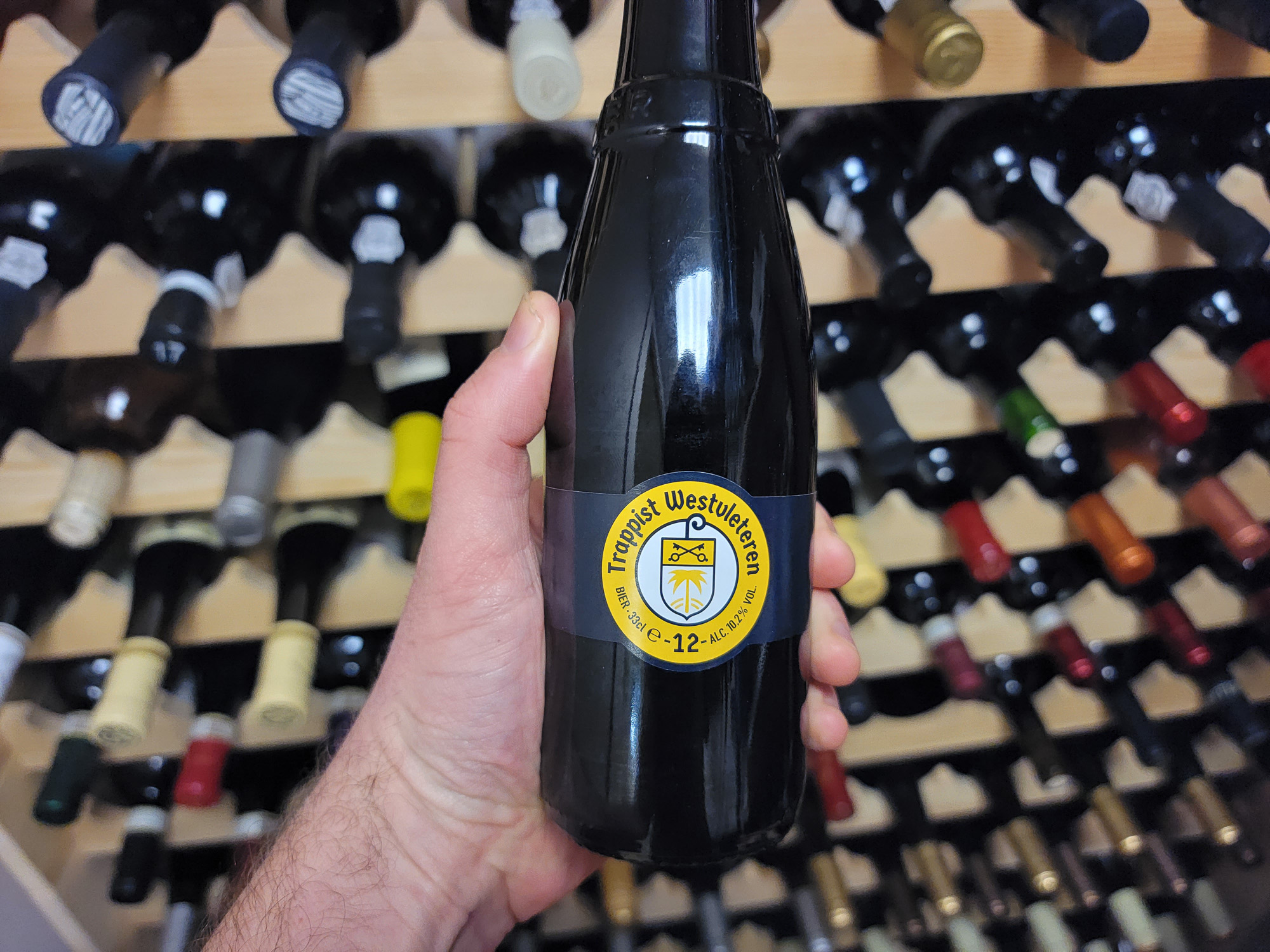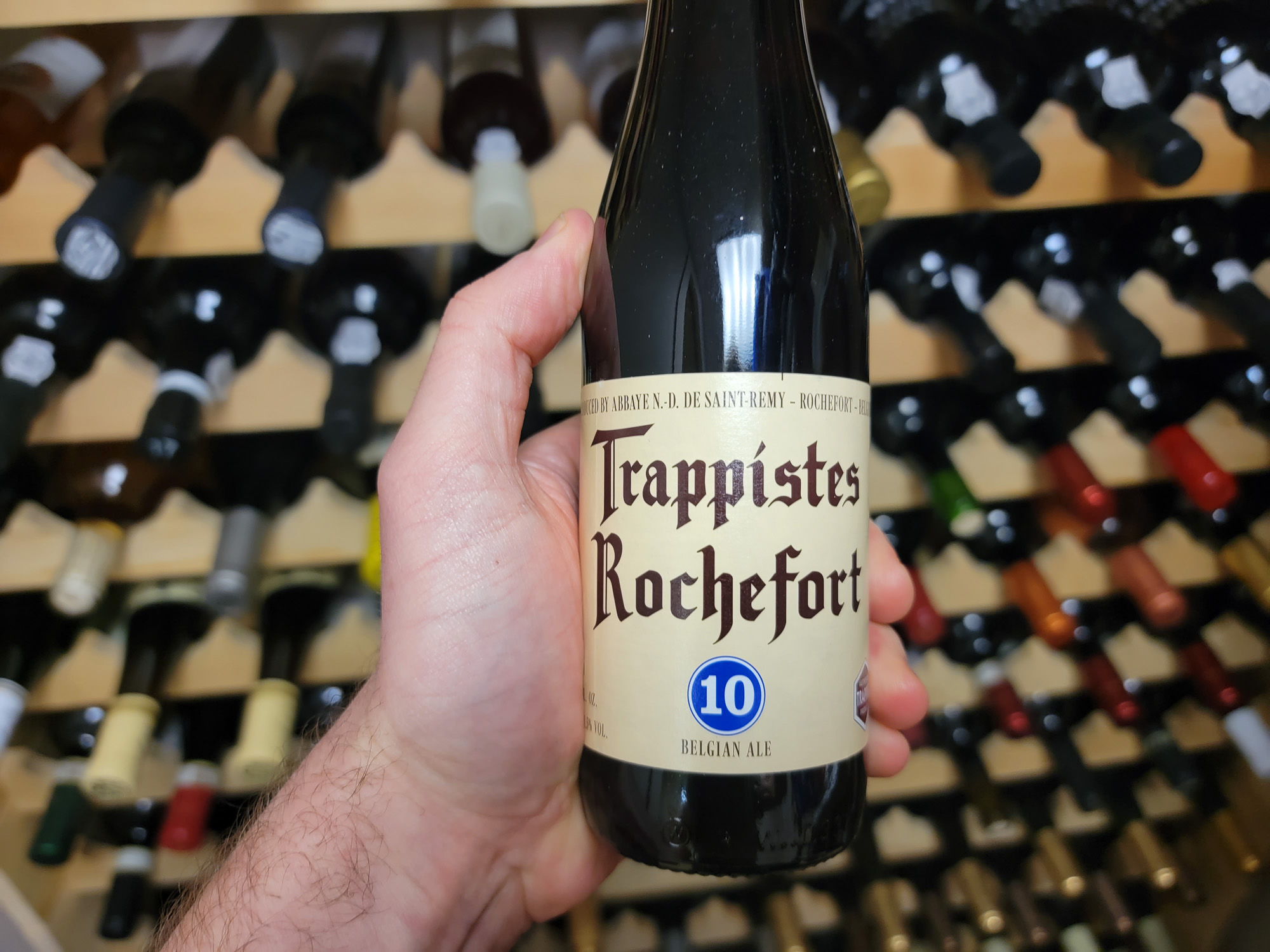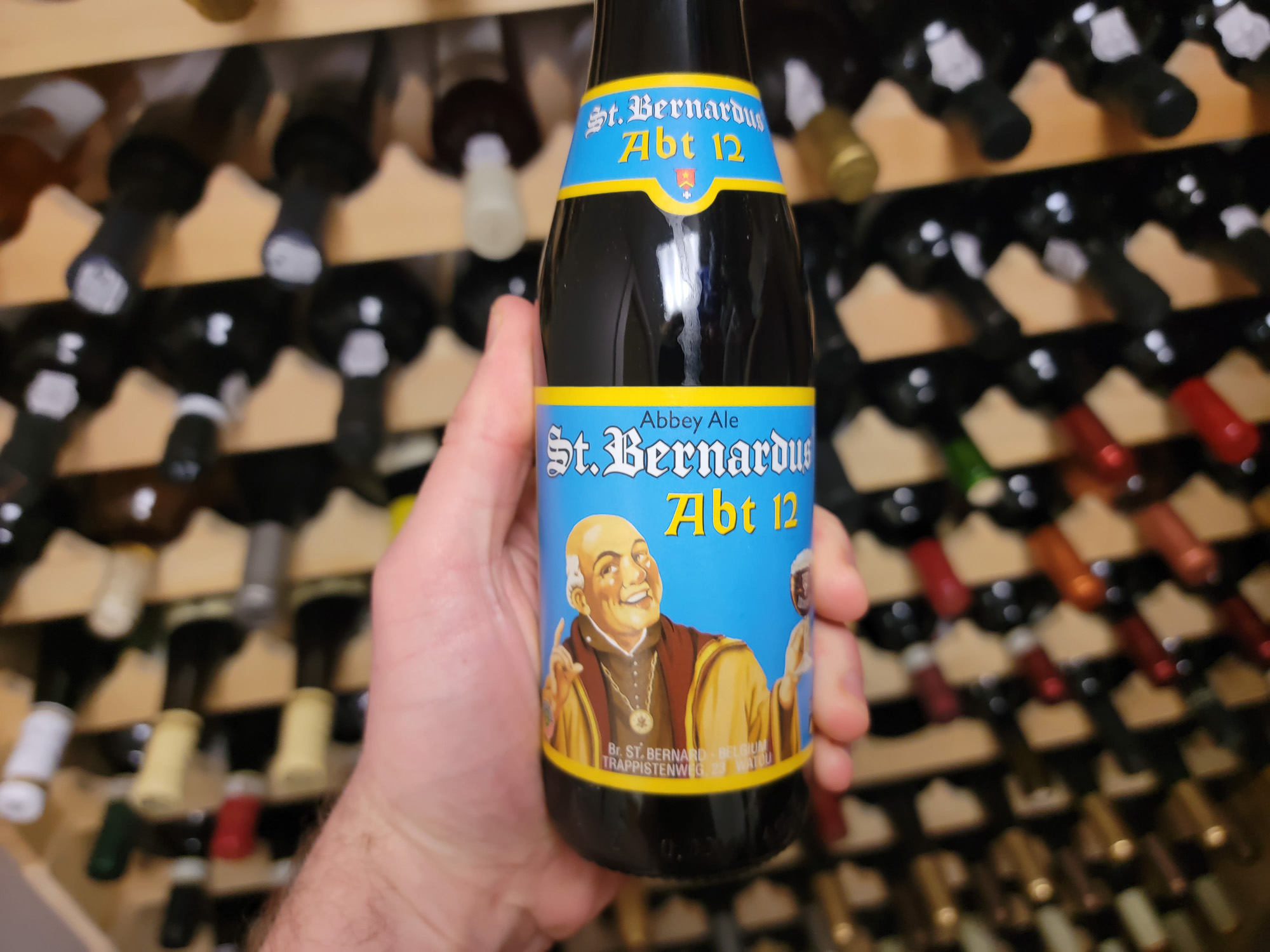Published by Jeremy. Last Updated on January 11, 2023.
Disclaimers: Our site uses demographic data, email opt-ins, display advertising, and affiliate links. Please check out our Terms and Conditions for more information. Listed prices and attraction details may have changed since our visit and initial publication.
After going on a pilgrimage to buy Westvleteren beer in Belgium, we knew one of the first things we had to do when we got home was to try it next to other popular Belgian quadrupels (quads) to see how it stacks up.
While we enjoyed many famous quads when in the country, we never were able to sample some of the most famous in a proper side-by-side. So we gathered a couple friends, found a few more famous Belgian quads, and devised a blind taste test to see which one liked the most.
Our lineup put Westvelteren 12 vs Rochefort 10 vs St. Bernardus 12, three of the most famous quads in all of Belgium, against each other. For a bit of a twist, we also threw in a quad from a local producer in Pittsburgh, Strange Roots, for good measure.
So, how did the blind taste test turn out? We have some thoughts!
✈️ Book Your Next Trip
- • Planning a trip? Find a flight deal.
- • In need of a room? Check out hotel and apartment prices.
- • Taking a cruise? Find a cruise itinerary for your journey.
- • Don't overlook picking up a rental car or day tours as well!
Structure of the Westvleteren vs Rochefort vs St. Bernardus vs Local Quad Tasting
The setup of this tasting was simple. Myself, Angie, and two friends were going to taste the four quads side-by-side. Angie and I had tried all four of these beers separately in the past, but always individually so we never had any direct comparisons in a proper side-by-side. Our two friends love Belgian beers, including quads, but never have had any of these specific brews insofar as they can remember.
Angie volunteered to prepare the blind, so she knew the order of the lineup, and each beer received its own unique glass. Unfortunately, we do not own eight of the same glass to make this part truly even, but we own two of several styles. As we were tasting with another couple, we could at least ensure everyone had the same glass type for any given beer (e.g. Rochefort 10 in Glass A, Westvleteren 12 in Glass B, etc). This may have resulted in some variability in the tasting, as we all know that Belgian producers are sticklers for the right glass for each beer, but any differences here were likely minimal.
Ignoring the glass variation, as Angie prepared the flights, she knew which beer was in which but kept it to herself until the end. I knew what all four of the beers were, including the local quad (Nightside of Eden from Strange Roots), but did not know the order. Our friends knew we were trying Westvleteren 12 plus other Belgian quads but did not know any of the other beers nor that we threw in a local beer for a surprise twist.
In an effort of brevity, our quick tasting notes were as follows:
- Westvleteren 12 (10.2% ABV) – Primary notes of strong maltiness, a notable roasted profile, a slight bitterness that was pleasant, and one note of a slight metallic aftertaste. Another sipper agreed but we all felt it went away after a few sips.
- Rochefort 10 (11.3% ABV) – Primary notes of being well balanced, smooth, slightly sweet, and had rich caramel notes amongst many others. One note thought this was possibly lower in ABV than others (via heat on the palate, not the body) when it was in fact the highest, which we view as a positive comment.
- St. Bernardus 12 (10% ABV) – Primary notes of intense esters (perhaps the strongest of the bunch) and flavors comparable to Rochefort 10, above, but overall lighter in body and less intense on non-ester notes.
- Strange Roots Night Side of Eden (10% ABV) – Unfortunately, this beer opened up flat likely due to a slight packaging error. That being said, everyone said it was smooth, with a nice sweetness all around. The ester profile was lighter than any of the others and, while similar flavor profiles, was perhaps just a bit lighter intensity overall.
- The flavor intensity could be due to the carbonation issue, or not. Either way, everyone agreed this one was a strong showing despite this issue.
These were all discussed before the unveiling of the beers, and for one final bit of fun, everyone pointed to their favorite before Angie gave the grand reveal. The results, to me at least, were not terribly surprising.
The Results – 50/50 Between Westvleteren and Rochefort
The results of this tasting between myself, Angie, and two friends were practically unanimous. Two of us selected Westvleteren 12 as our favorite. Two of us selected Rochefort 10 as our favorite. All four of us selected the other as our second favorite (Rochefort 10 and Westvleteren 12 were the Top 2 for everyone). All four of us admitted it was so close we could have gone either way. We also agreed that all four beers were incredible across the board.
Let’s work from the bottom up and summarize the conversation that followed.
St. Bernardus 12 and our local quad were in the bottom two (not surprisingly, with an equal split here, too) for the same reason- flavor intensity. Both of these brews were just a bit lighter in flavor intensity than Westvleteren 12 and Rochefort 10. Complex? Yes. Flavorful? Yes, but just a bit less so in the intensity department.
I could argue that the Strange Roots was a bit lighter on the ester notes that we love in Belgians as well, but they were present to a decent degree. I have to admit that in the blind I recognized it as the local beer for precisely this reason. That being said, for a Pittsburgh brewery to even be within the conversation here is a stellar showing- flatness and all.
Oddly enough, we noted that our local beer also was the only one that was fully translucent, while the other three were visibly hazy (albeit slightly), which likely may have had some impact on the final complexity, too. However, we also have to go back to the fact that our local beer opened flat, which was a disappointment for this flight as another bottle we had opened previously was not. How much this impacted our final picks remains unknown.
- We intend to repeat this same blind with others in the future and will see how things fall there with a fresh bottle, although I do not think the results will change much.
Ultimately, the balance between Westvleteren 12 and Rochefort 10 had to do primarily with the bitterness (Westvleteren 12 was more bitter than the Rochefort 10 we tried) and that the Westvleteren 12 bottle we opened had a slight metallic aftertaste that, admittedly, went away within a few minutes as we drank more. These details were quite minor, and we all agreed that both of these beers are truly exceptional. It all came down to personal preference over anything else.
So, congratulations go out to Rochefort 10 and Westvleteren 12, you are our winners from this blind!
Blind Tastes Like These Have One (Possibly) Big Problem
After finishing our tasting, I realized we may have had a potential problem with the setup of our blind. Not only this, the issue may affect all blind tastings you may read about for lineups like these.
No, it wasn’t that our glasses were different (that could be a minor contribution since not every beer was in their properly designed glass- although Angie did pour the Westvleteren in the Westvleteren glass). Instead, it was that we did not buy all of these beers in Belgium directly from the abbeys and that the chain of custody was outside of our hands for an indeterminate period of time. The Rochefort 10 and St. Bernardus 12 were purchased in the United States, and as these bottles tend to only illustrate their Best By date and not bottling date, they could potentially be (significantly) different in age.
We know for a fact that the Westvleteren 12 was young, likely just a few weeks or months old, because we bought our cases directly from the abbey in Belgium. The local beer from Strange Roots was also likely young because we purchased that directly from the brewery at release as soon as we got home from Belgium (whether they mature it before release is another question). The other two, well, your guess is as good as ours. It takes time to travel from Belgium to random beer stores in the USA where we found these bottles, so we have to assume that these two beers were older to an unknown degree.
If this difference was pushing years, not months or weeks, you may have an issue as maturation in-bottle comes into play.
This is important because Belgian quads like these are often said to be at their peak within 2-3 years of bottling. Bitter notes mellow, fresh hop profiles fade, other flavors develop, impurities may drop out, and so on. Even with just a regular beer cap, the beer inside the bottle does change with time, and we think this may have happened here.
If I could share an anecdotal story to highlight this point, it would be that when we were in Belgium, I had pegged my favorite order as Westvleteren 12 -> Rocherfort 10 -> St. Bernardus 12. I did not drink these side-by-side, to be fair, and was probably hyped up as we drank Westvleteren at In de Vrede next to the abbey (which is a pilgrimage experience if there ever was one). But my order at the time came down to thinking Rochefort 10 was slightly more bitter than Westvleteren 12 and St. Bernardus was also the lightest all around.
Cut to our blind tasting above, and the main differences I said were that Rochefort was less bitter than the Westvleteren, and the St. Bernardus was less intense than both. As I know that, without a doubt, bitterness is a characteristic that mellows out with age, this illustrates an issue you could possibly have with blind tastings if your brews are not bottled around roughly the same time. Did we have a young Rochefort 10 in Belgium and an older one in the USA? I would not be surprised if that answer is yes.
Whether your palate cares or not is another story.
Ultimately, this is also somewhat of a moot point because all of these beers are incredible. Westvleteren 12 and Rochefort 10 in particular are stellar beers, and St. Bernardus 12 is less intense from all of our tasting experiences.
Will I complain if any showed up in front of me in a glass? Heck no. Am I excited to see what our Westvleteren 12 tastes like in a few years with a bit of age? Absolutely. Will I crack one open with a US-found Rochefort to do another, possibly more comparable side-by-side? You know it. Do I think a young Westvleteren 12 would likely beat a young Rochefort 10 if I am right about all of this? I would lean to saying yes, but honestly, after this exercise, it is so close I don’t really care- both are excellent.
Either way, drink these beers and be merry. And if you’re located in Pittsburgh, don’t sleep on Strange Roots’ Nightside of Eden if it is available, either.
Have you tried a blind of Westvleteren 12 vs Rochefort 10 vs St. Bernardus 12? What did you think of it? Comment below to share!
About Jeremy
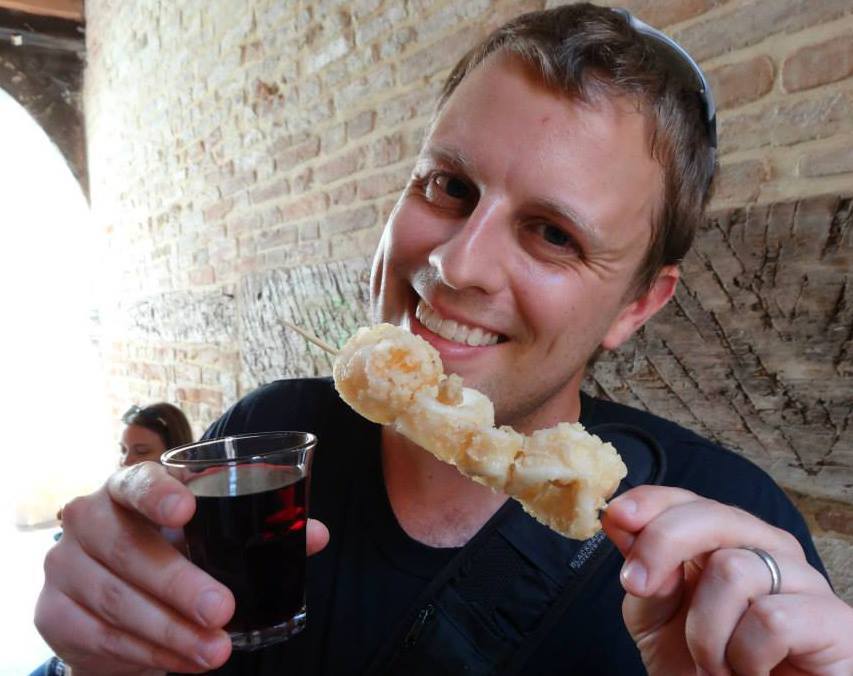
About the Author: Jeremy is a full-time travel writer based in Pittsburgh and primary author of this site. He has been to 70+ countries on five continents and seeks out new food, adventure activities, and off-the-beaten-path experiences wherever he travels.
